NEET Biology is the scoring paper in the medical entrance examination. Here, you will discover the NEET Biology MCQ Questions for all Concepts as per the latest syllabus. Practice more on a regular basis with these NEET Biology objective questions on air pollution and improve your subject knowledge & problem-solving skills along with time management. NEET Biology Gymnosperm Multiple Choice Questions make you feel confident in answering the question in the exam & increases your scores to high.
MCQs on Gymnosperm
1. ‘Saccus’ term is used for
(a) exine of pollen grains of Pinus
(b) intine of pollen grains of Pinus
(c) Wings of pollen grains of Pinus
(d) Wings of seeds of Pinus
Answer
Answer: (c)
2. Flowers and cones are similar because
(a) both assist seed dispersal
(b) both are responsible in attracting insects to pollinate
(c) both are shoy and bright
(d) both are reproductive structures
Answer
Answer: (d)
3. An autotrophic, prokaryotic, nitrogen fixing symbiont is present in
(a) Cicer
(b) Cycas
(c) Sequoia
(d) Pinus
Answer
Answer: (b)
4. Pick the pair that is incorrectly matched
(a) Cycas – coralloid roots
(b) Abies – wood tar, wood gas
(c) Pinus – Mycorrhizal roots
(d) Sequoia – Red wood tree
Answer
Answer: (b)
5. This serves as a connecting link between the angiosperms and gymnosperms
(a) Gnetales
(b) Coniferales
(c) Ginkgoales
(d) Cycadales
Answer
Answer: (a)
6. Though Cycas has an embryo with two cotyledons, it is not grouped under dicotyledonous plants, as:
(a) ovules are naked
(b) possesses compound leaves
(c) has megasporophyll
(d) resembles a palm tree
Answer
Answer: (a)
7. In gymnosperms, the ovules typically are
(a) bitegmic and anatropous
(b) bitegmic and orthotropous
(c) unitegmic and orthotropous
(d) unitegmic and anatropous
Answer
Answer: (c)
8. Tallest known gymnosperm is
(a) Pinus
(b) Ginkgo
(c) Sequoia
(d) Ephedra
Answer
Answer: (c)
9. Inverted omega shaped organization of the vascular bundles is seen in
(a) cycas root
(b) cycas stem
(c) cycas leaflet
(d) ctclas rachis
Answer
Answer: (d)
10. Phanerograms without the ovaries are
(a) angiosperms
(b) pteridophytes
(c) gymnosperms
(d) all the above
Answer
Answer: (c)
